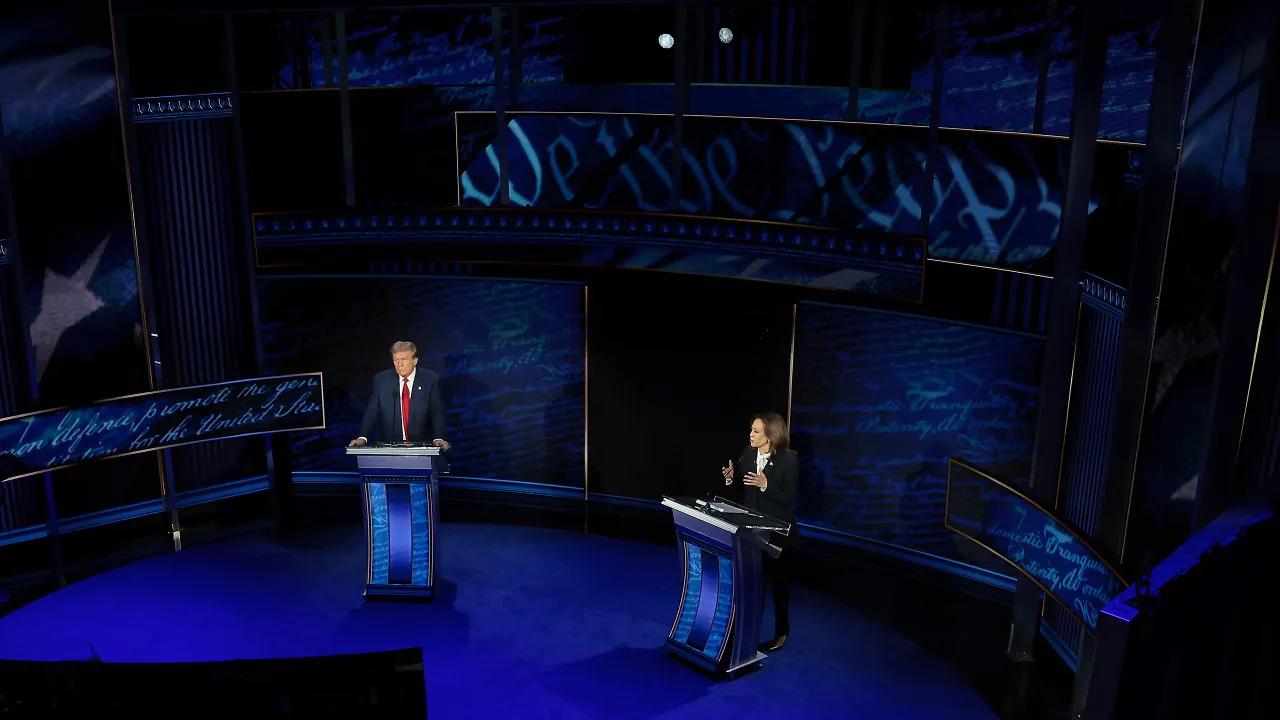The debate stage wasn’t glitzy—and it was bad news for Trump
If there’s one word that could be used to describe the debate stage where Vice President Kamala Harris and former president Donald Trump met on Tuesday, it’s demure. The dark blue set at the National Constitution Center in Philadelphia was designed to look serious and unassuming—a neutral, subdued setting for the candidates competing to become America’s 47th president. It didn’t demand attention because that wasn’t its job; and the setting ultimately played to the strengths of the former prosecutor over the former reality-TV show host. Rather than an open set with an audience, Harris and Trump debated in a small circular auditorium that’s used for tour group audiovisual presentations. The tight quarters made Harris’s walk across the set to shake Trump’s hand and introduce herself short, and decidedly less awkward. The lack of audience and muted microphones when candidates weren’t talking kept the program on track. A flash poll of viewers conducted by SSRS research company for CNN found Harris came out ahead. The poll showed 63% of viewers thought Harris won, and viewers’ favorable ratings of her rose from 39% before the debate to 45% after it, while Trump’s favorable rating among viewers remained unchanged at about 39%. A NONPARTISAN PRECEDENT For 32 years, debate-staging decisions were the realm of the nonpartisan Commission on Presidential Debates, which hosted every presidential debate from 1988 to 2020. When it came to sets, the commission tended to play things straight. Unlike network-hosted primary campaign debates, which can be packed with modern, bright, dynamic video screens and commercial breaks, the commission’s debates used staid, patriotic staging. Beginning in 1992, the commission displayed an image of a bald eagle holding a banner in its beak that reads, “The Union and the Constitution Forever.” In 2008, it started to use a blue background that showed text from the Declaration of Independence. Design elements remained largely unchanged from election to election, giving commission-sponsored debates a familiar, consistent look. But when Trump and President Joe Biden agreed in May to attend debates hosted by news outlets instead of by the Commission on Presidential Debates, that put the onus on networks to design a stage of their own. DEBATE DESIGN INSPO: LESS GLITZ, MORE GOVERNMENT For CNN’s presidential debate in June, the network stuck with the style of its bright, branded staging used for primary debates. ABC News, which hosted the Harris-Trump debate, changed course. Though the network has used dynamic video screens and bright contemporary staging for primary debates in the past, the staging on Tuesday was dark and reserved. The backdrops even showed text from the Constitution, reminiscent of the old commission-sponsored debate backdrop with founding-document script. On a set designed for a would-be president, Harris came across as more prepared and presidential than the person on that stage who’s actually been president before. The muted mics gave Harris space to articulate her policies while cutting down on interjections that could break the flow of the debate. And the lack of audience meant Trump had no one to play to. Without any audience interaction, candidates had to rely on their oratory skills alone. The fact that ABC News developed an understated set that evoked civic symbols, like the Commission on Presidential Debates had in the past, suggests the network was aiming to similarly create a set that looked staid and nonpartisan, dialing down the bravado in favor of a considered contest. It’s easy to imagine how Trump’s false claim of immigrants eating people’s pets, or his repeated false claims of crime being up in the U.S. but down everywhere else in the world, would work better with a friendly, engaged crowd. But in the confines of the National Constitution Center set without a studio audience, they fell flat, with no audience members to react and egg him on—essentially the opposite of the comments section of a Truth Social post. This debate was designed to test candidates on the issues and their records, more World News Tonight than reality-TV show, and a majority of viewers agreed that Harris won. The serious-minded staging only helped to reinforce her performance.

If there’s one word that could be used to describe the debate stage where Vice President Kamala Harris and former president Donald Trump met on Tuesday, it’s demure.
The dark blue set at the National Constitution Center in Philadelphia was designed to look serious and unassuming—a neutral, subdued setting for the candidates competing to become America’s 47th president. It didn’t demand attention because that wasn’t its job; and the setting ultimately played to the strengths of the former prosecutor over the former reality-TV show host.
Rather than an open set with an audience, Harris and Trump debated in a small circular auditorium that’s used for tour group audiovisual presentations. The tight quarters made Harris’s walk across the set to shake Trump’s hand and introduce herself short, and decidedly less awkward. The lack of audience and muted microphones when candidates weren’t talking kept the program on track.
A flash poll of viewers conducted by SSRS research company for CNN found Harris came out ahead. The poll showed 63% of viewers thought Harris won, and viewers’ favorable ratings of her rose from 39% before the debate to 45% after it, while Trump’s favorable rating among viewers remained unchanged at about 39%.
A NONPARTISAN PRECEDENT
For 32 years, debate-staging decisions were the realm of the nonpartisan Commission on Presidential Debates, which hosted every presidential debate from 1988 to 2020. When it came to sets, the commission tended to play things straight. Unlike network-hosted primary campaign debates, which can be packed with modern, bright, dynamic video screens and commercial breaks, the commission’s debates used staid, patriotic staging.
Beginning in 1992, the commission displayed an image of a bald eagle holding a banner in its beak that reads, “The Union and the Constitution Forever.” In 2008, it started to use a blue background that showed text from the Declaration of Independence. Design elements remained largely unchanged from election to election, giving commission-sponsored debates a familiar, consistent look. But when Trump and President Joe Biden agreed in May to attend debates hosted by news outlets instead of by the Commission on Presidential Debates, that put the onus on networks to design a stage of their own.
DEBATE DESIGN INSPO: LESS GLITZ, MORE GOVERNMENT
For CNN’s presidential debate in June, the network stuck with the style of its bright, branded staging used for primary debates. ABC News, which hosted the Harris-Trump debate, changed course. Though the network has used dynamic video screens and bright contemporary staging for primary debates in the past, the staging on Tuesday was dark and reserved. The backdrops even showed text from the Constitution, reminiscent of the old commission-sponsored debate backdrop with founding-document script.
On a set designed for a would-be president, Harris came across as more prepared and presidential than the person on that stage who’s actually been president before. The muted mics gave Harris space to articulate her policies while cutting down on interjections that could break the flow of the debate. And the lack of audience meant Trump had no one to play to.
Without any audience interaction, candidates had to rely on their oratory skills alone. The fact that ABC News developed an understated set that evoked civic symbols, like the Commission on Presidential Debates had in the past, suggests the network was aiming to similarly create a set that looked staid and nonpartisan, dialing down the bravado in favor of a considered contest.
It’s easy to imagine how Trump’s false claim of immigrants eating people’s pets, or his repeated false claims of crime being up in the U.S. but down everywhere else in the world, would work better with a friendly, engaged crowd. But in the confines of the National Constitution Center set without a studio audience, they fell flat, with no audience members to react and egg him on—essentially the opposite of the comments section of a Truth Social post. This debate was designed to test candidates on the issues and their records, more World News Tonight than reality-TV show, and a majority of viewers agreed that Harris won. The serious-minded staging only helped to reinforce her performance.






















